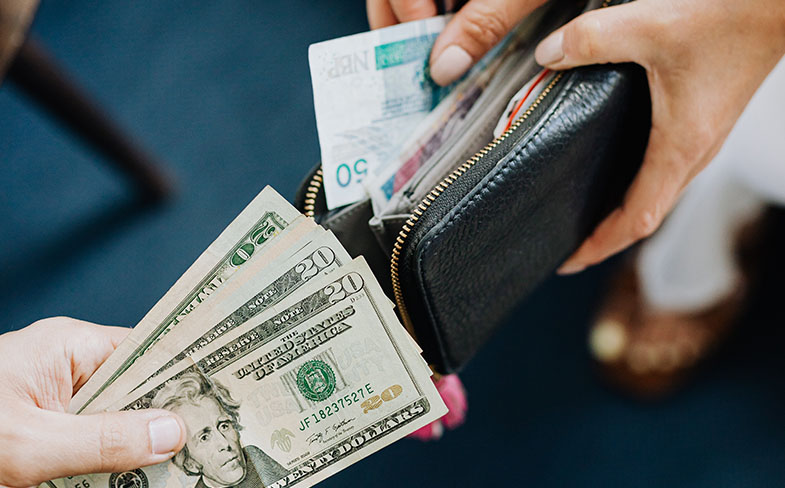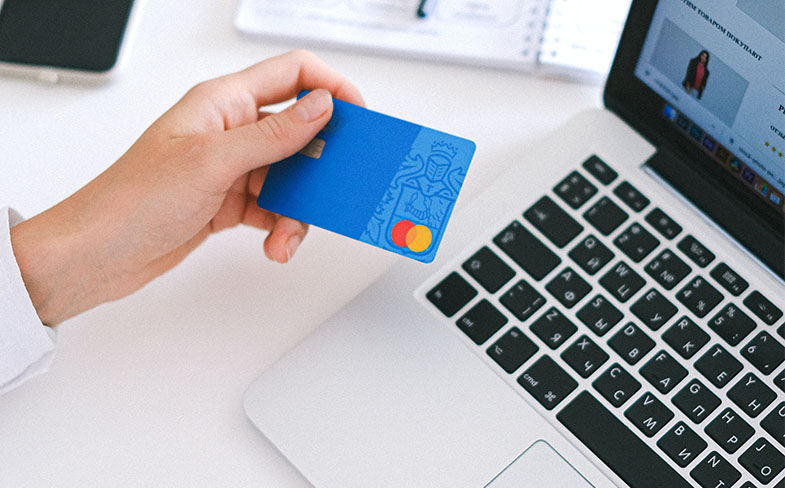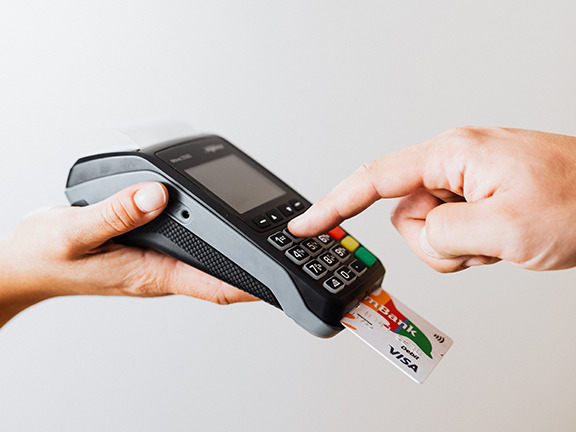Where There’s a Bill, There’s a Way to Pay
About the Activity
Buying things is a part of growing up, having your own money, and taking care of yourself. It also means that you have to figure out how to pay for the things you want to buy.
In this activity, you’ll learn about the different ways you can pay for items in person and online, and explore the upsides and downsides to each method.

Materials
Here’s what you’ll need to complete this activity:
A pen or pencil
A piece of paper
Activity Steps
Part 1: How We Pay For Things
Shopping in person requires you to carry cash, a credit card, a debit card, or a check to pay for things. When shopping online, you need a credit card, electronic funds transfers or online payment services. Which one is best depends on what you prefer, and what you can afford.
It’s important to note that shopping online is almost always more expensive than shopping in person; it might be easier, but you usually have to pay for shipping, which means it is usually at least a little more expensive to buy something online than it is in-person.
Always talk to an adult before you purchase anything online. They can help you consider your payment options that work for your budget.

 Did you know?
Did you know?Before humans had modern societies, they paid for goods with things like fish, animal skins and furs, and salt. This is called bartering.
Part 2: The Many Ways to Pay
Let’s explore the many ways to pay for things—and the benefits and drawbacks of each.
Cash: It’s the simplest to use, but you can only use it in-person. A benefit of paying in cash is there are no added processing fees from the store you’re buying things from, like there may be for other forms of payment. Some stores might even offer a discount if you pay with cash.
Checks: Checks used to be the most common way of paying for things, especially bills. People would carry checkbooks around with them, would write checks and mail them to pay their bills. Today, you’ll likely get a checkbook when you open a checking account, but many people prefer to use cash or credit cards instead because the payments are processed immediately (or at least a lot faster than checks).
Debit Cards: A debit card is a physical card like a credit card, but it is connected to your checking or savings account and gives you access to however much is in that account. You can use a debit card to pay for things at many, but not all retailers, and there is sometimes a fee charged for using one.
ATM Cards: An ATM card, like a debit card, is connected to your checking or savings account and gives you access to however much money is in that account. An ATM card will also let you take physical cash from your account by using an ATM machine. One downside is that some ATMs will charge a fee for withdrawing money if they are not affiliated with your bank.

 Did you know?
Did you know?ATM stands for Automatic Teller Machine. You can find them at most banks as well as many shopping destinations, such as the grocery store, the mall, and some restaurants.
Credit cards: There’s lots to say about credit cards, but the first thing to note is that these days they are a pretty common way to pay for things – more so than they were even ten years ago. Most stores accept them, and many prefer them. Retailers generally don’t charge a fee for you to use most credit cards; but some do, because they have to pay the credit card company a small percentage of every transaction. The retailers that don’t charge you for that money pay it themselves.
And, of course, you should know that credit cards charge you interest on whatever you still owe them at the end of every monthly billing cycle, so each month that you don’t pay off your entire balance, you pay the credit card company more and more money.
Electronic Funds Transfer (EFT): An electronic funds transfer is another way of making a payment, and can be used for buying things online. To enable an EFT you’ll have to type in specific information about your bank account, including the bank routing number. This is used for more formal and often larger financial transactions. Your parents may use this to pay regular monthly bills, like the electric or cable bills.
App-Based Payment Services: App-based payment services are meant to make it easier to make digital payments from your smartphone. Retailers who accept payments from these services won’t charge you extra for it, but note that if your payment service is tied to your credit card, the payment service might charge you a percentage on each transaction. Read the fine print of your mobile payment app to find out.
 Did you know?
Did you know?Credit card payment types include Visa, Master Card, Discover, American Express, and debit card payment types include PLUS, Maestro, Cirrus, Novas, Start, or NYCE. Common app-based payment types include PayPal, Square, Google Wallet, Dwolla, V.me by Visa, Serve, from American Express, and many more! How many of these companies do you recognize?
Part 3: Time to Buy
- Ready to shop for shoes? Here’s a common scenario. Jordan needs a new pair of sneakers—or, at least, he wants a new pair of sneakers. Either way, Jordan is determined to buy them.Jordan goes to sneakerhub.com, the only place in this pretend world to buy sneakers, and sees they are $110. It’s a lot, but he’s been saving up. He has $115 in his checking account; he also has a credit card.
- Jordan reviews his purchasing options. Sneakerhub.com offers premium 2-day shipping, and Jordan wants these sneakers fast. But the two-day shipping costs $24. That would make these sneakers cost a total of $134—that’s a 22% added cost!Next, he looks at the standard, non-rush shipping. Jordan sees he can get these sneakers in 5-10 business days for the standard rate of shipping, which still costs an extra $10. Even that is a 9% increase over the original cost of these shoes.Jordan knows that sneakerhub has a store at his local mall, where he could go and buy them and not pay the shipping cost—but he doesn’t have a car, and a bus ride would take an hour each way. Plus, between school and everything else, he’s pretty busy!
- Pretend you are Jordan, and consider how you would buy these shoes. Keep in mind a couple of things as you decide:
- The online store accepts credit card and online payment services; it also takes debit cards for a 2% fee.
- The physical retail store accepts cash, check, and credit card, or debit card for also a 2% fee.
- Jordan knows he does not always pay off his credit card balance each month, and his credit card charges a 16% APR. That means whatever is left unpaid at the end of each month has 16% added onto the balance. Right now Jordan’s credit card is paid off, but he’s not sure he could pay off these sneakers before next month because he doesn’t have a job right now.
- What would you do?
- Option 1: Go to the store and pay wih a credit card.
- Option 2: Go to the store and pay with cash or a check.
- Option 3: Buy online with a credit card and pay for premium shipping.
- Option 4: Buy online with a credit card and pay for regular shipping.
- Option 5: Wait until he has more money to buy.
There’s not necessarily a right answer here, but consider your choice option, and explain your reasoning for that payment method on a sheet of paper.
Test Your Knowledge
See how much you’ve learned about using different payment methods!
Reflection Questions
Ask a parent or other adult how they pay their bills.
Has it changed over the years?
Do they use a credit card or write a check?
How about EFTs?
Have the changes been good or challenging from their perspective?
Investigate and Explore

Credit cards are an increasingly popular way to pay for things, online, of course, but in person, too.
At the end of this activity, we introduced the concept of credit card debt, and how that debt is added onto each month that the full balance is not paid off. That 16% interest rate is actually lower than some credit cards charge and they often target young people.
Think about what you need to buy, or what you would like to buy, and what would happen to your credit card debt if you didn’t pay off that bill every month. There is a cost to convenience, you just have to decide if you can afford it.
Career Connections
Regardless of your career path, it’s wise to learn how to manage your own money. If banking and finance piques your interest, you might find success in any number of careers, from economics to accounting. Whether you see yourself working as a bank teller or a mortgage broker, or dream of a day where you own your own business, understanding the fundamental principals of currency will be important at work.





